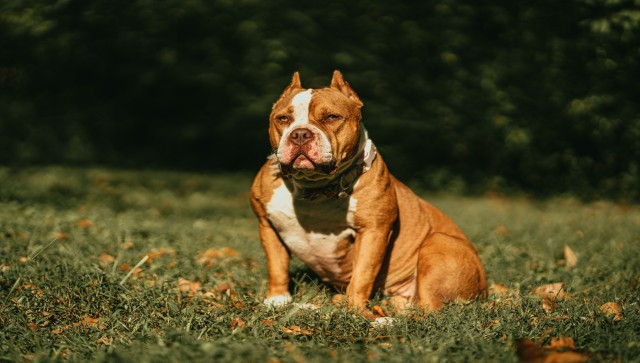By the end of the year, the American XL bully will be outlawed in the United Kingdom, said British Prime Minister Rishi Sunak on Friday. Taking to X (formerly Twitter), the UK Prime Minister said, “The American XL Bully dogs are a danger to our communities, particularly our children,” adding that he shared “the nation’s horror” over videos of recent dog attacks. “It’s clear this is not about a handful of badly trained dogs, it’s a pattern of behaviour and it cannot go on,” Sunak said in a video message.
He said a man was killed on Thursday in central England in an attack involving a suspected XL bully dog. Police said a man had been arrested on suspicion of manslaughter. Notably, if the ban comes into place, it will be the first breed to be added to the prohibited list under the act since the law was introduced in 1991. Also read: Gurugram bans 11 dog breeds: What are they? How dangerous are they?
About XL bully dogs American Bully comes in four sizes: normal, pocket, classic, and XL. The XL is the largest type, as per BBC. The American XL Bully has a weight range of over nine stone (60 kg), making him powerful enough to overwhelm an adult. According to Reuters, American Pit Bull Terriers and American Staffordshire Terriers were crossed in the US in the late 1980s to create American Bullies. To produce an even more muscular dog, they have been bred with various breeds. Despite its intimidating appearance, an American Bully “makes an excellent family dog,” according to the United Kennel Club in the US. It says that “some level of dog aggression is characteristic of this breed,” while noting that “aggressive behaviour towards humans is uncharacteristic.” While the American Bully is recognised as a distinct breed in the US, the major dog organisations in Britain do not. [caption id=“attachment_13132822” align=“alignnone” width=“640”] American Bully comes in four sizes: normal, pocket, classic, and XL. The XL is the largest type. Pixabay[/caption] Bully Watch, a UK advocacy group, claims that the breed was relatively new to the country when it first arrived “around 2014 or 2015,” but its popularity spiked during the coronavirus outbreak. It says they account for less than one per cent of all owned dogs across the country. Also read: For the Love of Dog: How once-popular breeds like rough collies, bloodhounds are likely to go extinct in the UK
The debate There is a heated debate between people who believe that some dogs are bred to be killers and those who believe that all dogs are born with those traits. In the UK, six of the ten fatal dog attacks that occurred in 2017 and at least three of the seven this year have been connected to XL bullies. More than half of all fatal dog attacks in Britain last year were caused by this breed, according to the advocacy group Bully Watch, which supports a ban on the sale and breeding of massive XL Bully dogs. The New York Times cited data from the Office for National Statistics, as stating that three people died in Britain year on average between 2001 and 2021 as a consequence of dog attacks. According to certain advocacy groups, the XL Bully is inherently harmful and possible inbreeding may increase traits like aggression. Because of its size and strength, any attacks or bites are more likely to be severe. While, a number of British animal welfare charities, including the RSPCA, said this week that banning specific dog breeds is not the solution. In a joint statement, they instead blamed “irresponsible breeding, rearing and ownership” and said the government should instead focus on “dog control regulations, and on promoting responsible dog ownership and training”. The reason they are being banned The mother of 10-year-old Jack Lis, who was killed by an XL Bully in 2021, is among the campaigners advocating for a ban. The home secretary, Suella Braverman, announced she was seeking “urgent advice” on a ban in response to a video showing an XL Bully cross-breed escaping its collar and attacking people in a street in Birmingham over the weekend, including an 11-year-old girl who was bit on the arm and shoulder. [caption id=“attachment_13132852” align=“alignnone” width=“640”]
American Bully comes in four sizes: normal, pocket, classic, and XL. The XL is the largest type. Pixabay[/caption] Bully Watch, a UK advocacy group, claims that the breed was relatively new to the country when it first arrived “around 2014 or 2015,” but its popularity spiked during the coronavirus outbreak. It says they account for less than one per cent of all owned dogs across the country. Also read: For the Love of Dog: How once-popular breeds like rough collies, bloodhounds are likely to go extinct in the UK
The debate There is a heated debate between people who believe that some dogs are bred to be killers and those who believe that all dogs are born with those traits. In the UK, six of the ten fatal dog attacks that occurred in 2017 and at least three of the seven this year have been connected to XL bullies. More than half of all fatal dog attacks in Britain last year were caused by this breed, according to the advocacy group Bully Watch, which supports a ban on the sale and breeding of massive XL Bully dogs. The New York Times cited data from the Office for National Statistics, as stating that three people died in Britain year on average between 2001 and 2021 as a consequence of dog attacks. According to certain advocacy groups, the XL Bully is inherently harmful and possible inbreeding may increase traits like aggression. Because of its size and strength, any attacks or bites are more likely to be severe. While, a number of British animal welfare charities, including the RSPCA, said this week that banning specific dog breeds is not the solution. In a joint statement, they instead blamed “irresponsible breeding, rearing and ownership” and said the government should instead focus on “dog control regulations, and on promoting responsible dog ownership and training”. The reason they are being banned The mother of 10-year-old Jack Lis, who was killed by an XL Bully in 2021, is among the campaigners advocating for a ban. The home secretary, Suella Braverman, announced she was seeking “urgent advice” on a ban in response to a video showing an XL Bully cross-breed escaping its collar and attacking people in a street in Birmingham over the weekend, including an 11-year-old girl who was bit on the arm and shoulder. [caption id=“attachment_13132852” align=“alignnone” width=“640”] Despite its intimidating appearance, an American Bully “makes an excellent family dog,” according to the United Kennel Club in the US. Pixabay[/caption] A 65-year-old grandmother from Liverpool was killed in April when she attempted to break up a fight between her two American bullies at her home. The coroner stated that she had suffered “catastrophic injuries” when she was discovered. Sunak made the announcement a few hours after news broke that a man in Staffordshire had been killed following an assault by two dogs which were thought to be XL bullies. Also read: Mutt Menace: Do we need stricter norms to deal with the rise in attacks by pet dogs?
The process of ban The Dangerous Dogs Act states that prohibited dogs are recognised by their physical traits, as judged by a police officer skilled in dog handling and dog legislation, known as a dog legislation officer. Unless the owner requests an exception from the court, police can confiscate and destroy banned canines. Exemptions may be given if the dog is neutered, microchipped, and owned by a person who is “fit and proper” to be in care of a dog. These conditions must all be met in order for the dog to qualify. Four breeds were outlawed in the nation in 1991 when the Dangerous Dogs Act was passed: the pit bull terrier (possibly the ancestor of the XL Bully), the Japanese tosa, the Dogo Argentino, and the Fila Brasileiro. It was implemented following a string of 11 horrific assaults that year, including the mauling of a six-year-old girl when she was out for a family stroll in Bradford. Since then, the first Bully to be added to the list will be the XL Bully. Its effectiveness It appears from the evidence that outlawing a breed will only cause their numbers to decline. 25 years after the introduction of the Dangerous Dog Act, data from the Metropolitan Police from 2015–16 revealed that 19 per cent of dog attacks in London were committed by prohibited pit bull terriers. The RSPCA claimed that adding another breed to the list “will only see history repeat itself” because during the course of 20 years, from 1999 to 2019, the number of hospital admissions for the treatment of dog attacks climbed by 154 per cent. Since the pit bull terrier was outlawed, there is a risk that comparable breeds would emerge or be introduced as a result of the ban, much to how the American bulldog has become more well-liked. With inputs from agencies
Despite its intimidating appearance, an American Bully “makes an excellent family dog,” according to the United Kennel Club in the US. Pixabay[/caption] A 65-year-old grandmother from Liverpool was killed in April when she attempted to break up a fight between her two American bullies at her home. The coroner stated that she had suffered “catastrophic injuries” when she was discovered. Sunak made the announcement a few hours after news broke that a man in Staffordshire had been killed following an assault by two dogs which were thought to be XL bullies. Also read: Mutt Menace: Do we need stricter norms to deal with the rise in attacks by pet dogs?
The process of ban The Dangerous Dogs Act states that prohibited dogs are recognised by their physical traits, as judged by a police officer skilled in dog handling and dog legislation, known as a dog legislation officer. Unless the owner requests an exception from the court, police can confiscate and destroy banned canines. Exemptions may be given if the dog is neutered, microchipped, and owned by a person who is “fit and proper” to be in care of a dog. These conditions must all be met in order for the dog to qualify. Four breeds were outlawed in the nation in 1991 when the Dangerous Dogs Act was passed: the pit bull terrier (possibly the ancestor of the XL Bully), the Japanese tosa, the Dogo Argentino, and the Fila Brasileiro. It was implemented following a string of 11 horrific assaults that year, including the mauling of a six-year-old girl when she was out for a family stroll in Bradford. Since then, the first Bully to be added to the list will be the XL Bully. Its effectiveness It appears from the evidence that outlawing a breed will only cause their numbers to decline. 25 years after the introduction of the Dangerous Dog Act, data from the Metropolitan Police from 2015–16 revealed that 19 per cent of dog attacks in London were committed by prohibited pit bull terriers. The RSPCA claimed that adding another breed to the list “will only see history repeat itself” because during the course of 20 years, from 1999 to 2019, the number of hospital admissions for the treatment of dog attacks climbed by 154 per cent. Since the pit bull terrier was outlawed, there is a risk that comparable breeds would emerge or be introduced as a result of the ban, much to how the American bulldog has become more well-liked. With inputs from agencies
)